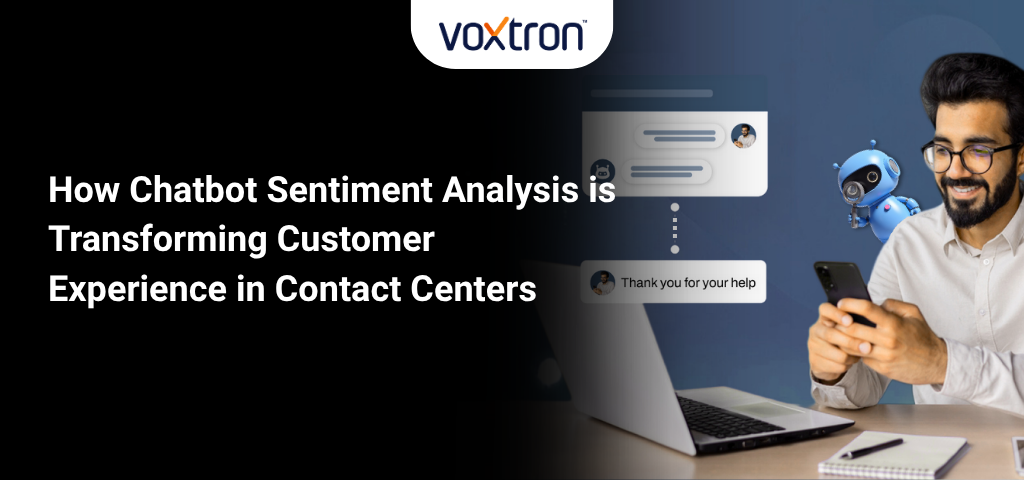
The Odoo Implementation Timeline: What to Expect?
November 19, 2025How Chatbot Sentiment Analysis is Transforming Customer Experience in Contact Centers
Today’s customers want more than quick solutions. They want to feel heard and understood when they contact a business for a query or solution.
However, when businesses rely on traditional chatbots for customer interactions, they often miss this mark. Chatbots respond to words, not emotions. As a result, they fail to deliver a human touch during communication.
Modern chatbots with sentiment analysis overcome this problem.
Let us take an example. Picture this: a frustrated customer contacts a business after waiting days for a response from support.
The bot replies with a neutral greeting, “How may I assist you today?”
The conversation feels mechanical, distant, and cold.
Now imagine the same customer interacting with a chatbot powered by sentiment analysis. The bot immediately detects the frustration in tone or phrasing and begins with empathy: “I’m sorry you’ve had a tough time. Let’s fix this right away.”
With the shift in tone and emotion, the customer develops more trust.
According to recent studies, companies integrating sentiment analysis in chatbots have recorded up to a 25% increase in customer satisfaction and 20% lower churn rates. In fact, almost 68% of service teams now use AI technologies like sentiment analysis to enhance response quality and empathy in interactions. This emotional intelligence enables brands to transform reactive service models into proactive, human-like experiences that strengthen loyalty.
Engage 360 by Voxtron integrates this emotional awareness into every digital conversation. More than a technical enhancement, it’s a shift toward emotionally intelligent automation. Here, the goal isn’t just to resolve queries but to truly connect with customers.
Understanding Sentiment Analysis
Sentiment analysis is a form of artificial intelligence that interprets the emotional tone behind words and voice. It leverages natural language processing (NLP) and machine learning (ML) to respond in a more human way.
Unlike traditional response systems that treat each query in isolation, sentiment analysis tracks emotion across the entire conversation. It helps identify moments of tension, recovery, and relief. Thus, it mirrors how a human agent would read a caller’s inflection or written tone.
Chatbots with sentimental analysis understand whether a customer feels frustrated, satisfied, or confused. In a contact center, this emotional awareness enables customer interactions to break free from purely transactional boundaries.
Why Emotion Matters in Customer Experience
The emotional quality of an interaction often defines customer perception more than speed or resolution. A chatbot that fails to recognize irritation during a repeated complaint may inadvertently escalate frustration. Meanwhile, one that acknowledges feelings early can diffuse tension.
Sentiment-aware systems identify linguistic markers like pacing, punctuation, and tone of response to evaluate customer mood. This analysis enables the chatbot to shift tone dynamically when detecting a negative response or neutrality when encountering ambiguity.
Emotionally intelligent automation turns service from a functional process into an empathetic exchange. Customers who feel heard are statistically twice as likely to remain loyal and four times more likely to recommend the brand to others.
How Sentiment Analysis Works within Engage 360
At the core of Engage 360’s sentiment-aware chatbot lies a multi-layered process combining NLP, contextual scoring, and continuous learning.
- Data Collection: Customer interactions, whether text, voice, or chat, are continuously analyzed.
- Emotion Detection: The NLP engine identifies cues such as tone variations, wording patterns, and intensity markers.
- Classification: Each interaction segment is labeled as positive, negative, or neutral, often with subcategories such as angry, appreciative, or confused.
- Adaptive Response: Depending on the emotional score, the chatbot adapts tone, escalates to a human agent, or reinforces positive sentiment.
By learning from each interaction, the chatbot’s AI refines its understanding of context over time. This enables more natural, emotionally resonant exchanges. This continuous emotional feedback loop not only personalizes engagement but also provides management teams with insights into customer mood trends and areas needing operational improvement.
Measurable Impact on Contact Centers
Organizations using emotion-detection AI in their customer interactions report a 25% increase in customer satisfaction and up to a 20% reduction in escalation rates.
Beyond traditional KPIs, the technology drives value on three levels:
- Customer Impact: Emotional recognition fosters connection. Customers perceive their issues as genuinely understood, increasing satisfaction and trust.
- Operational Efficiency: Real-time identification of negative sentiment enables proactive intervention, helping teams prioritize high-risk conversations before they become escalations.
- Agent Empowerment: Sentiment data equips supervisors to coach agents more effectively, providing context-rich insights into performance and customer emotion drivers.
In Engage 360, these metrics are integrated into analytics dashboards, giving managers a unified view of customer mood patterns that inform training, script improvements, and automation strategies.
Turning Insights into Strategy
The power of sentiment analysis extends beyond the interaction itself. Emotional insights compiled across thousands of conversations reveal long-term behavioral trends. This helps the business anticipate customer needs in a proactive manner.
By linking Engage 360’s sentiment data with CRM or ERP platforms, contact centers can discover correlations between customer mood and purchase intent or service feedback. Negative sentiment trends might highlight policy bottlenecks or training opportunities, while positive clusters can indicate campaign effectiveness.
In this way, businesses move toward predictive care using emotion-led data not only to resolve issues but to shape better products, experiences, and relationships.
The Future of Emotionally Intelligent Chatbots
Engage 360 by Voxtron combines sentiment recognition with predictive analytics and adaptive dialogue to deliver an automation model that grows more human over time. This evolution moves the contact center from being a reactive cost center to a proactive customer engagement hub.
As voice, text, and social messaging channels continue to converge, sentiment analysis is becoming increasingly important for truly omnichannel contact experiences. Future chatbots will likely merge emotional intelligence with behavioral forecasting to anticipate customer issues before it frustrates them.
Conclusion: From Customer Service to Customer Connection with Engage 360
Sentiment analysis is redefining what automation feels like. It bridges the long-standing gap between speed and empathy and between solving a problem and understanding a person.
Through Engage 360, contact centers are entering an era where chatbots no longer just respond to queries; they listen, adapt, and empathize. The outcome is a seamless blend of intelligence and emotion. Thus, it provides an experience where every interaction, however automated, still feels unmistakably human.
For more details on Engage 360 and how it can empower your business, contact our team today.




